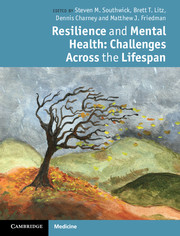Book contents
- Frontmatter
- Contents
- Contributors
- Preface
- Section 1 Pathways to resilience
- Section 2 Resilience across the lifespan
- 7 Resilience in children and adolescents
- 8 Toward a lifespan approach to resilience and potential trauma
- 9 Resilience in older adults
- Section 3 Resilience in families, communities, and societies
- Section 4 Specific challenges
- Section 5 Training for resilience
- Index
- References
8 - Toward a lifespan approach to resilience and potential trauma
from Section 2 - Resilience across the lifespan
Published online by Cambridge University Press: 07 September 2011
- Frontmatter
- Contents
- Contributors
- Preface
- Section 1 Pathways to resilience
- Section 2 Resilience across the lifespan
- 7 Resilience in children and adolescents
- 8 Toward a lifespan approach to resilience and potential trauma
- 9 Resilience in older adults
- Section 3 Resilience in families, communities, and societies
- Section 4 Specific challenges
- Section 5 Training for resilience
- Index
- References
Summary
Introduction
As much as we might wish it otherwise, bad things happen: war, natural disaster, the death of close friends and relatives, serious accidents, senseless abuse or violence at the hand of others, and so on. Any of these things can and all too often do happen, and at every stage of life. Epidemiological data indicate that most adults experience at least one and usually several potentially traumatic events (PTE) during the course of their lives (Norris, 1992; Kessler et al., 1995; Breslau et al., 2000), and that most children are also exposed to such experiences (Copeland et al., 2007). It is important to note, however, that life event research typically relies on retrospective accounts, which more than likely underestimate the frequency of PTEs. Indeed, a recent study that measured life events among college students over a four-year period using a weekly internet survey reported an average of six PTEs per student (Lalande & Bonanno, 2011).
Perhaps because acutely aversive events are so dreaded, both clinicians and the lay public tend to assume that they will almost always result in lasting emotional damage. The available evidence, however, suggests a more complex and far more encouraging picture. To emphasize the pronounced individual differences in the way people react to adversity, we emphasize that such events are only “potentially traumatic” (Norris, 1992; Bonanno, 2004), for the simple reason that not everyone experiences them as traumatic. Most people in fact cope with PTEs remarkably well (Bonanno, 2004, 2005; Bonanno & Mancini, 2008). Although some do, in fact, endure lasting emotional difficulties, the vast majority of people exposed to extreme adversity recover a semblance of their normal level of functioning within several months to several years after the event, and many if not most show little evidence of more than transient disruptions in functioning.
- Type
- Chapter
- Information
- Resilience and Mental HealthChallenges Across the Lifespan, pp. 120 - 134Publisher: Cambridge University PressPrint publication year: 2011
References
- 8
- Cited by



